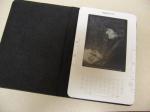Big Bangs
In the hyper-paced evolution of consumer technologies, there are few developments that equal the transformative effects of e-publishing.
Traditional publishing is now adapting to the reality of the Kindle, Sony e-reader, iPod Touch, and iPhone, which are being adopted by consumers at a rate not seen since the invention of the wheel. I wasn't present during that paradigm shift, but it is reasonable to assume that the Mesopotamians in the 5th millenium BC 'got it' and didn't look back wistfully to the old, pre-wheel, pre-personal empowerment days. Now, once again in humankind's evolution, we have a better idea that has authors and readers leapfrogging industry. Publishers have cultivated content and fed readers' appetites. But they have become a little too comfortable with the perquisites of the traditional corporate model, like Detroit automakers, the Big Three television networks, and the music industry. In each case, we the people have found our way to a better idea, a better way.
Now Amazon's Jeff Bezos is betting on the Kindle as a market maker, and if the rapidly increasing sales of the e-book tablet keep growing at the pace they have in the last year, he may be the man we credit with a Steve Jobs-like vision that changed the way we consume media content.
Heads Up: Prices Falling
Publishers see the change happening, know that their traditional print business model is struggling and have apparently decided to profit from the chaos in the book selling market by charging similar prices for hardcover and e-books. Today at Borders, I overheard a salesperson explaining e-books to a middle-aged couple at the Sony E-Reader display this way.
"E-books are coming down in price to roughly half the cost of a hardcover, from $15 to $17."
The couple were eager for the convenience offered by the E-Reader and when they heard about the cost-savings on titles, they decided to purchase the Sony.
Maybe I should have intervened and told them about $9.99 titles at Amazon. You don't criticize someone's family when you're a guest in their living room; and I won't disrupt Borders' business when I am in theirs. The couple are happily curled up on their couch now with Dan Brown's Lost Symbol on the E-Reader. Everyone is happy. As for the pricing, publishers will hang on to their profit margins and will change only when their business infrastructure collapses around them.
Meanwhile, over at Amazon, Jeff Bezos is offering e-books for download to the Kindle for $9.99. Amazon may lose on the margin in the near term, but it is establishing the $9.99 price point for books much in the same way that Steve Jobs established .99 cents as the single unit price point on iTunes, which is now the worldwide standard. More rapid adoption by more consumers will more than make up the difference.
More significantly to me, e-publishing redefines the business model. Suddenly, the artist and writer can, if they wish, become their own publishers. No more expenses like printing, shipping, trucking, warehousing, distribution, freight, fuel. It's irresistible and, as Adam Penenberg says in his article "The Evolution of Amazon" in the July/August edition of Fast Company, "it's irreversible." Literary agent Richard Curtis, who is also founder of E-Reads, an independent book publisher, asks,
why would "anybody need a traditional book publisher when you can essentially make Amazon your buyer and your seller in one stroke?"
iPublish
After years of playing by Publishing's rules - willingly, loyally, and with respect for its professionalism - the time has come to try other approaches to connect with my readers. I am going to try posting a story or two in Amazon's Kindle Store and see if I can reconnect with former readers and meet some new readers. I'll let you know how it goes.



